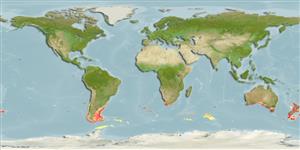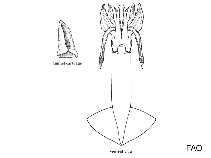Todarodes filippovae Adam, 1975
Antarctic flying squid| Native range | All suitable habitat | Point map | Year 2050 |

|
| This map was computer-generated and has not yet been reviewed. |
| Todarodes filippovae AquaMaps Data sources: GBIF OBIS |
Изображение на Google | No image available for this species;
drawing shows typical species in Ommastrephidae.
Классификация / Names народные названия | синонимы | CoL | ITIS | WoRMS
Cephalopoda | Oegopsida | Ommastrephidae | Todarodinae
Environment: milieu / climate zone / пределы глубины / distribution range экология
пелагический; пределы глубины 0 - 500 m (ссылка 275), usually 200 - ? m (ссылка 275). Polar; 32°S - 64°S, 180°W - 180°E (ссылка 275)
Distribution страны | регионы FAO | Ecosystems | места находок | интродукции
Circumpolar in Southern Ocean; south of approximately 35°S, Antarctic Convergent zone.
Length at first maturity / Size / Weight / Возраст
половая зрелость: Lm ? range ? - ? cm Max length : 55.5 cm ML самец/пол неопределен; (ссылка 122358)
Life cycle and mating behavior половая зрелость | размножение | нерест | Eggs | Fecundity | Larvae
Основная ссылка
ссылки | координатор | соавторы
Roper, C.F.E., M.J. Sweeney and C.E. Nauen 1984 FAO Species Catalogue. Vol. 3. Cephalopods of the world. An annotated and illustrated catalogue of species of interest to fisheries. FAO Fish. Synop. 125(3):277p. Rome: FAO. (ссылка 275)
Статус Красного Списка МСОП
(ссылка 130435: Version 2025-1)
Статус СИТЕС (ссылка 108899)
CMS (ссылка 116361)
Угроза для людей
Использование человеком
рыболовство: коммерческий
| FishSource |
инструменты
дополнительная информация
ресурсы в Интернет
BHL | BOLD Systems | CISTI | DiscoverLife | FAO(Publication : search) | Fishipedia | GenBank (Геном, Нуклеотид) | GloBI | Gomexsi | Google Books | Google Scholar | Google | PubMed | Tree of Life | Wikipedia (Вперёд, поиск) | Zoological Record



